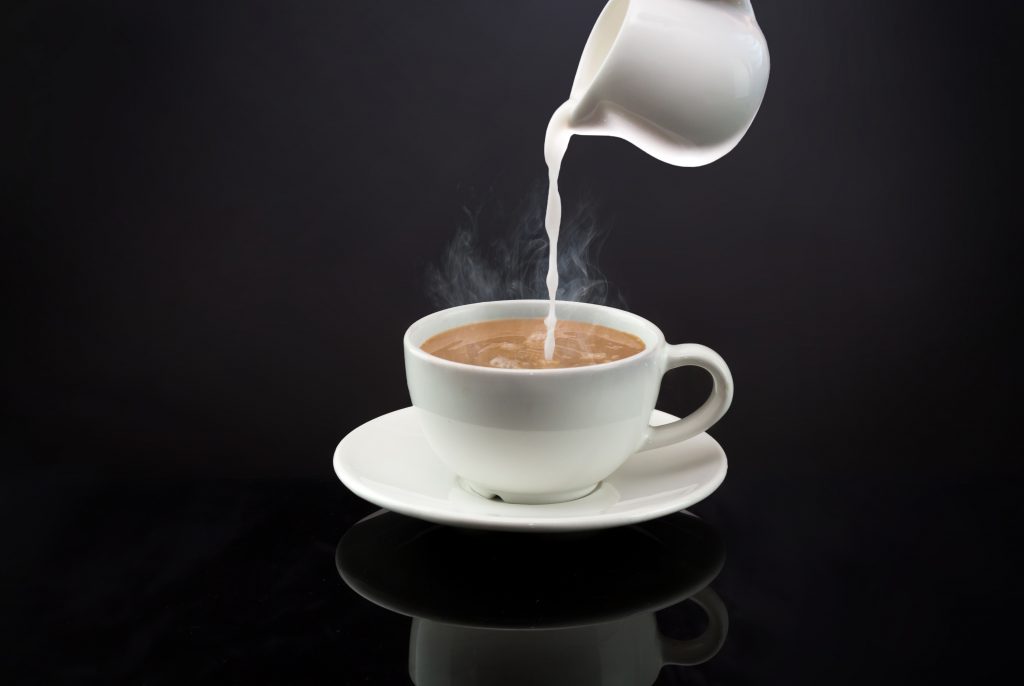Knowing that a product may have dairy ingredients can be especially important to allergic individuals, for whom consuming even the smallest dairy ingredient can have dire consequences. In addition, a product’s flavors may contain dairy, even in such small amounts that you won’t see that reflected on the label.
Due to the importance of flavor in food, by Jewish law, a negligible amount of dairy may still affect a product’s designation as dairy. That’s why it’s so important to know exactly what’s in the foods we eat.
Learn more about the complexities of dairy and kosher, and OU’s Dairy certification:
Q. What does “DE” mean?
A. The label OU-DE (Dairy Equipment) signifies that although the product itself does not contain any dairy ingredients, it was produced on equipment that also produces dairy products with no kosherization taking place between runs (which would remove the dairy status of the equipment). This differs from an item that is cooked directly with a dairy product and may therefore not be eaten without waiting the requisite amount of time (e.g., six hours) after one has consumed meat. Sephardic Jews consider DE items to be pareve (not dairy or meat). Ashkenazy Jews however, do not eat such items together with meat; however, it is permissible to eat DE products immediately after consuming meat without waiting.
Q. I bought a package of cookies labeled OU-D. I don’t see any milk or butter listed in the ingredients. Can I assume it is really only DE?
A. When reviewing a label to see if a product contains any dairy ingredients, one should be aware that many products contain “natural flavors,” which may indeed include dairy ingredients. Natural flavors are defined in the United States under regulation 21 CFR 101.22 of the FDA as “any product of … plant material, … dairy products, or fermentation products, … whose significant function in food is flavoring.” Although flavors usually constitute a tiny amount relative to the total ingredients, they contribute substantially to the taste of the food because they are highly concentrated. Thus, while a ratio of 60:1 generally suffices to nullify a non-kosher, or in this case dairy, ingredient, flavors cannot be nullified since they are noticeable.
Q. I have a similar question about a box of doughnuts labeled OU-D. All the ingredients are clearly pareve. Is there a need to contact the OU to verify that it is only DE?
Yes, it is best to check with the OU as it is very possible that such doughnuts contain actual dairy ingredients. Factories that produce doughnuts often boil non-dairy doughnuts in the same fryer used for dairy doughnuts. It is common for the oil to be filtered and then reused to boil the next batch. In such a case, the non-dairy doughnuts are considered tavshil shel gevinah (food cooked with dairy) because they were boiled in the same oil used for dairy. The custom is that one who ate meat must wait before eating a tavshil shel gevinah just as one waits before eating actual dairy.
Q. I noticed that some products, such as non-dairy creamer, are described as “non-dairy” but are labeled OU-D. Isn’t that a contradiction?
Although the name implies that the creamer does not contain dairy ingredients, the truth is that names can be deceiving. Very often, “non-dairy” creamers contain the dairy ingredient casein, usually in the form of sodium caseinate. Casein is a milk protein; it is the principal ingredient in cheese. Casein, however, lacks the lactose allergen. As such, it is not viewed as being dairy from a legal perspective, but from the perspective of Jewish law, it very much is.
Manufacturers are allowed to label products “non-dairy” even if they contain dairy ingredients. This is the result of regulations passed by the FDA years ago. The FDA forbade the use of the word “dairy” as a descriptive term when the dairy content of an item is below a certain level. For example, some varieties of “non-dairy” margarine contain butter or other dairy ingredients, but in small enough quantities that the manufacturer can label it as “non-dairy.”
Manufacturers are allowed to label products ‘non-dairy’ even if they contain dairy ingredients.
Q. What is the status of OreoTM sandwich cookies? Do they contain actual dairy ingredients?
A. This is one of the most popular questions we get. In fact, you can have certain types of Oreo cookies after your cholent as they are made on dairy equipment but are not actually dairy. The OU can provide you with a list of OreoTM cookies that are DE but not dairy.
However, bear in mind that the manufacturer may choose to reformulate these products and add dairy ingredients any time in the future. Since these products already bear OU-D symbols, formulation changes would not be reflected in the OU-D logo. As such, we recommend that consumers check regularly with our office to confirm the status of these products.
Q. I bought a box of OU-certified pareve crackers. However, the ingredient label states that the crackers are manufactured in a factory that processes dairy. Is there a mistake? Are these really pareve?
A. Yes, the crackers are pareve. Companies place warnings on packaging so that those who are extremely sensitive to allergens can be made aware that the item may contain airborne dairy particles. By Jewish law, this does not make the item dairy. Even if there was cross-contamination with dairy, the amount is too minuscule to affect the taste, and therefore it is batel (nullified).
Special thanks to Rabbi Eli Eleff, managing director of OU Kosher Community Relations, for helping to prepare this article for publication. The information is adapted from OU Kosher’s Halacha Yomis, a daily email containing brief halachic (Jewish law) tidbits . To sign up to receive Halacha Yomis, visit oukosher.org/halacha-yomis/.

